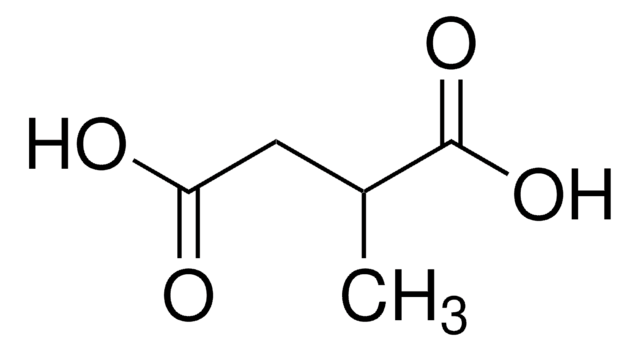G3407
Glutaric acid
99%
Sinónimos:
1,3-Propanedicarboxylic acid, 1,5-Pentanedioic acid
About This Item
Productos recomendados
Análisis
99%
bp
200 °C/20 mmHg (lit.)
mp
95-98 °C (lit.)
solubilidad
water: soluble 5 mg/mL, clear to slightly hazy, colorless to faintly yellow
alcohol: soluble(lit.)
chloroform: soluble(lit.)
cadena SMILES
OC(=O)CCCC(O)=O
InChI
1S/C5H8O4/c6-4(7)2-1-3-5(8)9/h1-3H2,(H,6,7)(H,8,9)
Clave InChI
JFCQEDHGNNZCLN-UHFFFAOYSA-N
¿Está buscando productos similares? Visita Guía de comparación de productos
Categorías relacionadas
Descripción general
Glutaric acid (Pentanedioic Acid) is a linear dicarboxylic acid. It has been prepared by oxidizing cyclopentane, cyclopentanol and cyclopentanone.
Aplicación
- Complexation with DL-lysine. Complexes have been reported to possess zwitterionic lysinium ions (positively charged) and semi-glutarate ions (negatively charged).
- Synthesis of complexes with L-arginine and L-histidine.
- Preparation of glycine-glutaric acid co-crystals. Phase transition studies of these cocrystals have been reported by single-crystal X-ray diffraction, polarized Raman spectroscopy and differential scanning calorimetry.
Palabra de señalización
Danger
Frases de peligro
Consejos de prudencia
Clasificaciones de peligro
Eye Dam. 1 - Skin Corr. 1A
Código de clase de almacenamiento
8A - Combustible corrosive hazardous materials
Clase de riesgo para el agua (WGK)
WGK 1
Punto de inflamabilidad (°F)
Not applicable
Punto de inflamabilidad (°C)
Not applicable
Equipo de protección personal
dust mask type N95 (US), Eyeshields, Gloves
Certificados de análisis (COA)
Busque Certificados de análisis (COA) introduciendo el número de lote del producto. Los números de lote se encuentran en la etiqueta del producto después de las palabras «Lot» o «Batch»
¿Ya tiene este producto?
Encuentre la documentación para los productos que ha comprado recientemente en la Biblioteca de documentos.
Los clientes también vieron
Nuestro equipo de científicos tiene experiencia en todas las áreas de investigación: Ciencias de la vida, Ciencia de los materiales, Síntesis química, Cromatografía, Analítica y muchas otras.
Póngase en contacto con el Servicio técnico














